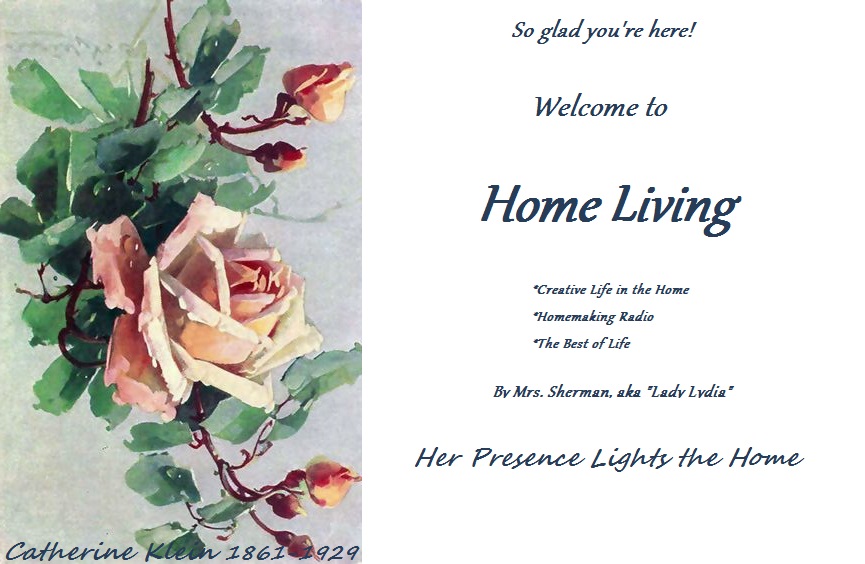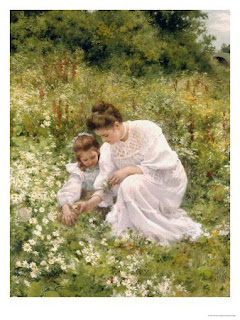
Miss Elspeth Mallock
by Edward Arthur Walton, Scotland
1860-1922
Two Girls at the Frame
by Alexander Max Koester, Germany(1864-1932)
The Pitcher Girl
by Victor Thirion , France (1832-1878)
Portrait of a Young Woman
Carl Timolean Von Neff, Estonia (1805-1877)
Mountaineers
by Charles Edward Boutibonne
France (1816-1897)
In the Garden
by Frederick Fursman
United States, 1874-1943
I have been absorbed in the study of textiles and clothing in the 19th century, and also enjoying the book, "Calico Chronicles: Texas Women and Their Clothing," which is available in various online bookstores. I only wish it had been in color. However, a friend told me about a magazine article she had read, which told about late 19th century color photography called "autochrome," which was made with potato starch to produce color. It was discovered and developed by the French, and was used before color photography as we now know it. In many ways, I think it looks better, and the people in the pictures more life-like.
Window Ledge Portrate (autochrome photograph)
by Marice Rampert 1907
I have been looking at the autochromes from the online public libraries, and would like to include them here.As I looked through these photographs, I was happy to see that they were not at all inconsistent with the artists of the time, which I have been showing regularly on this blog.
Alpine Group (autochrome photograph)
by Maurice Rampet (1866-1941)
Among the Irises (autochrome Photograph) 1924

Woman Reading in a Garden (autochrome color photograph from the early 1900's)
The above photo is very similar to paintings that I have shown here before. The one of the woman in the peasant blouse has very detailed painted lace. All of the dresses you see worn in the paintings and the photographs, can be sewn today, using current patterns. Just find a peasant blouse and a long skirt pattern and a vest. Some of the other photos and paintings can be immitated with what is called the "Garden Party Dress." Patterns for Garden Party dresses can be found at Jennie Chancey's pattern site and Costume sections of your pattern books at fabric stores, which I will post later.

Autochrome Photograph, early 19th century. Notice the pretty striped fabric and the lace collar and and cuffs . This appears to be a hand made matching mother and daughter (or sister) outfit. The autochrome has a very life-like appearance. Learn more about autochromes here
http://www.photographymuseum.com/exhibitstart.html
There is a way of looking at paintings and photography that helps you understand more about it. You can ask the following questions about them:
Where is the lightest part of the painting?
Where is the light coming from?
Is the painting portraying something warm and sunny, or cold and foggy?
What other colors do you see?
What are the people in the painting doing?
Name some other things you see in the room of the painting.
Point to other things in the painting that show how the people lived or what their activities were.
What is in the background of the painting?
Tell something about the hairstyles of the women in the paintings, as well as the clothing styles.
What do you think the focus or subject of the painting is?
Tell something about the fabrics you see on clothing or draperies.
What do you think the artist was trying to show?
Is there a mood in the painting, of happiness or contentment, excitment or adventure?
Part of the fun of viewing these paintings is the opportunity to pose them yourself, using similar props and scenes and clothing, and take photographs.
This is especially enjoyable with scenery or still life and with children.
Both the paintings and the photographs show that women and girls dressed femininely, and without wearing men's clothing, were quite active and engaged in hard work.
Speaking of potatoes, I have been busy getting mine out of the ground, washed, and stored.
There are several colors of potatoe: purple, red, gold and white. My favorite for flavor are the gold or yellow potatoes. They look yellow when cooked, as though they have butter in them, and have a lot more flavor than the other kinds. These are red potatoes. Potato growing is about the dirtiest work in the world, but at least my boots match my dress ;-)
These are some colors around here that are easily imitated in fabrics. I am sewing an autumn dress the color of the dark red leaves here. A burgundy colored dress, with a light green shawl is bright spot on autumn days when the light is dimmer, and it is also a pretty color on houses.



.jpg)
.jpg)












.jpg)
+(2).jpg)




.jpg)

.jpg)
.jpg)
.jpg)
.jpg)
.jpg)

.jpg)
.jpg)
